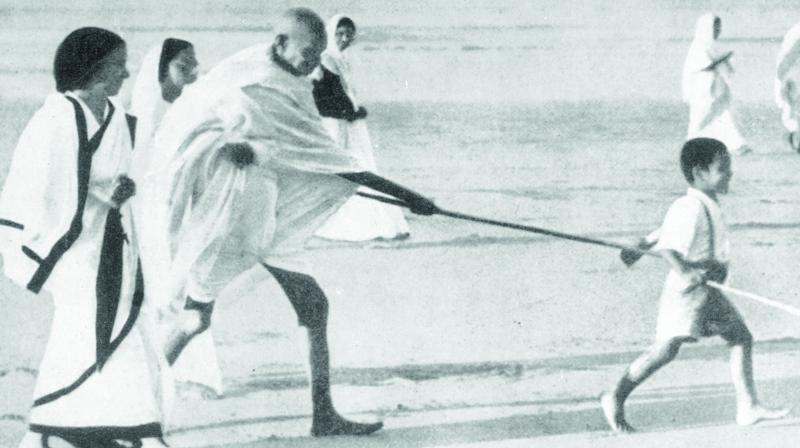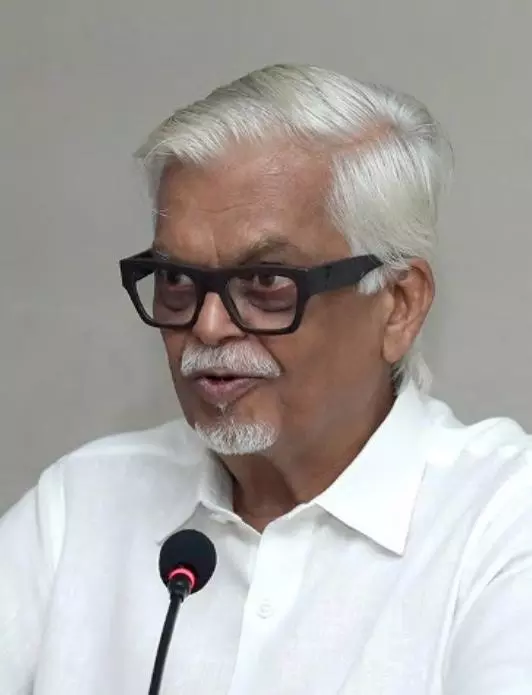Mahatma and the Congress

A joke A heard often these days is that Narendra Modi and Amit Shah, fellow Gujaratis, have finally helped fulfil the wish of the Sant from Sabarmati – of
winding up the Indian National Congress (INC). The question is what advise Mahatma Gandhi would have for the Congress of today when it appears to be on the threshold of being wound up.
The evidence on Gandhiji’s advise is disputed. It is true that on January, 27, 1948, three days before his assassination, Gandhiji penned an article subsequently published in Harijan (February 2, 1948) in which he suggested that now that Congress had achieved its historical goal, it had “outlived its use” and ought to be transformed into a social welfare organisation.
However, historian Sucheta Mahajan claimed that this essay was wrongly interpreted as Gandhiji’s “Last Will and Testament” by his associates, who published it posthumously, because in the same edition of Harijan, Gandhiji said, “Indian National Congress, which is the oldest national political organization, and which has after many non-violent battles fought her way to freedom, cannot be allowed to die. It can only die with the nation.”
Indeed, a “Congress-mukt Bharat”, a slogan purveyed in the aftermath of 2014 Lok Sabha elections, would not be the Bharat that Gandhiji had aspired for. He
believed in all values that the INC represented at the time of Independence. Gandhiji may well have desired that INC be separated into a social welfare
organisation, the kind his disciples like Vinobha Bhave would be part of, and a regular political party, the kind his disciples like Jawaharlal Nehru and Sardar
Vallabhbhai Patel would be part of. This is a more plausible hypothesis since he blessed both sets of disciples.
Gandhiji was both a “Yogi and a Commissar”, to borrow the title of Arthur Koestler’s famous book. Gandhiji was as engaged in philosophical discourse as he was in practical politics. His purpose in life was both to create a “new India” as well as a “new Indian”. It is this proposition that should guide what is now left
of the Congress, a goal that the BJP has now adopted.
Indian democracy deserves a healthy contestation between contending ideas of India.
To return to the question of Gandhiji’s parting advice – the fact is the INC of Gandhiji and his generation has long ceased to exist. It disappeared in the centenary year of Gandhiji’s birth, 1969, when the Congress party split and morphed into what came to be known unabashedly as “Indira Congress”. We can call Congress that came into being in 1998 under Sonia Gandhi as “Sonia Congress”.
The Indira Congress was the first ‘family-based’ political party because it is Indira Gandhi who began the trend of nominating her son as her political heir, when
she inducted Sanjay Gandhi and allowed him to exercise unquestioned powers, both within party and government. All other family-based political parties came
into being after the Emergency.
Sociologist Gyan Prakash summed up the emergence of family parties, “Emergency did not confer absolute power on Indira Gandhi. Instead, what took shape was something more insidious. Suspended laws let loose shadow powers and shadow laws. Nothing was more shadowy than Sanjay Gandhi and his coterie.
Functioning behind the scenes, this unlawful authority drew on the Prime Minister’s lawful authority to set free a powerful coercive force.”
Referring to this transition in his fictionalised autobiography, The Insider, P.V. Narasimha Rao famously observed “the party has become a proprietorship”.
So what would Gandhiji’s advise be to many disparate ‘Congresspersons’ around the country for reviving the Congress? Precisely the same advise he often gave
to disparate Congress persons through the freedom struggle –come and work together. There is no future for Sonia Congress, given that the generational
transition that she tried has backfired. If neither Rahul Gandhi nor Priyanka Vadra can lead the party back to power, who can?
Gandhiji’s answer would be that all those who began their political life in Congress should return and elect a new leader. This would mean merging of Mamata Banerjee’s Trinamul, Sharad Pawar’s Nationalist Congress and inviting back into Congress fold former Congress leaders like Chandrababu Naidu or Y.S. Jagan in Andhra Pradesh, K Chandrashekar Rao in Telangana and Biju Patnaik’s son in Odisha.
This group of former Congress affiliates would have to elect a new leader and organise themselves into a credible front against the BJP.
But organisational re-structuring and political engineering is only the beginning. This group would need a coherent ideology to confront the ideological platform
of the BJP. Only such a national mobilisation can revive the now moribund Congress. Indeed, leadership credibility is the biggest challenge facing today’s
Congress.
This is the exact situation BJP’s mentors found themselves in vis-à-vis Congress after Independence. Between 1947 to 1969, it was Congress that had credible
national leadership while BJP’s earlier avatar, Jana Sangh, had at best Atal Bihari Vajpayee to match the Congress pantheon.
Today, the BJP has an array of nationally recognised leaders while the Congress has reduced itself into a gathering of regional leaders.
Modi government’s handling of economic situation offers an opening for revival of Congress’s fortunes. If former Congress leaders can sink their individual
egos and come together to adopt a common minimum programme to revive higher and more equitable economic growth, they have a chance.
When Mohandas Karamchand Gandhi returned home from South Africa, it was Gopalakrishna Gokhale who advised him to travel the length and breadth of India to first understand people before he could lead them.
Those who want to revive Congress must understand the aspirations of a ‘New India’ before reclaiming it from Modi.
Indian democracy needs at least two national political parties. The absence of a national alternative to the Congress led to its split in 1969 and also allowed
flowering of many a regional party. Today’s India looks the same–one dominant national party and many regional parties. India deserves two national parties with contending visions.
The liberal democrat that he was, Mahatma Gandhi would certainly want to see the Congress revived. As a national and nationalist party, the BJP too should wish it’s principal opponent was a national party.

